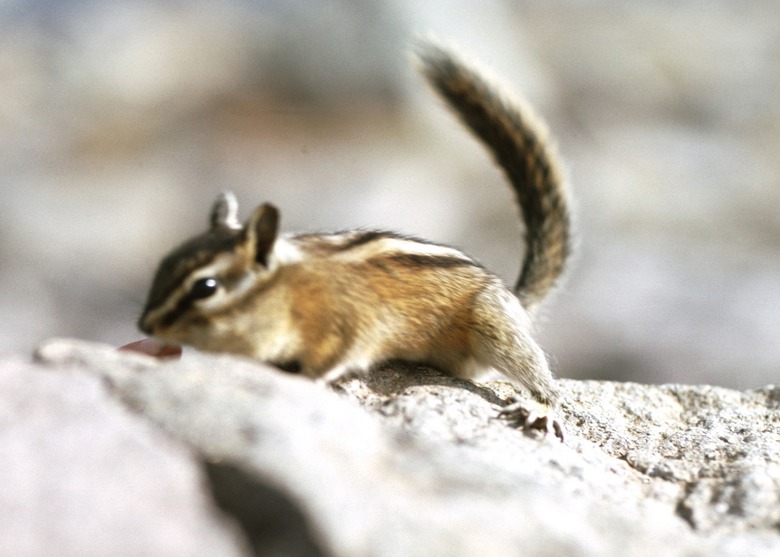Survival Adaptations For Chipmunks
Members of the squirrel family, chipmunks are agile critters with big, bushy tails and striped bodies. Chipmunks inhabit parts of a number of countries, including the United States and Russia. Common varieties in the U.S. include the red and brown-colored Eastern chipmunk, whose adaptations allow it to survive in a variety of habitats. Given their diverse habitats, chipmunks have adapted to survive in several ways, predominantly as a means to stay alive in winter and when food is scarce.
Cheek Pouches
Cheek Pouches
Chipmunks make use of specially adapted internal cheek pouches as a method of carrying food around. Chipmunk hibernation is a little bit of a misnomer; the chipmunk is not a true hibernator because during winter it occasionally eats food from its underground caches during this time, as well as from its cheek pouches.
Hibernation State
Hibernation State
Chipmunks in winter can survive through periods of food scarcity by reducing their respiration and heart rate, sending themselves into a state of torpor similar to that experienced by truly hibernating animals such as bears. In this state, the chipmunk only has to wake up occasionally to eat its stored food. Within the torpor state, the chipmunk lowers its respiration rate from 60 breaths per minute to 20 or fewer per minute. The chipmunk also has a lower overall body temperature during this time, being reduced to 45 degrees Fahrenheit from the usual 100 degrees. As outside temperatures increase, the chipmunk doesn't have to spend the entire season hidden away. It can easily leave its torpor state and become active when milder temperatures arrive.
Chipmunk Cries
Chipmunk Cries
Chipmunks have developed a range of cries that are utilized chiefly to warn of danger, but can double as a type of mating call when used by female chipmunks. These cries include a shrill and almost bird-like sound, which lasts for only a fraction of a second and is most often sounded in response to the appearance of danger.
Tree Climbing
Tree Climbing
Chipmunks are often called ground squirrels, and in comparison to their squirrel cousins spend much of their time foraging on the floor of their habitat instead of in trees. However, they are adapted to forage for food on upper levels if required by a scarcity of food elsewhere. Chipmunks are very able climbers, and their claws are adapted to allow this by being needle-pointed. Thus, the chipmunk is able to get the required purchase on a tree and reach food the food it finds there, such as berries and insects.
References
Cite This Article
MLA
Fuller, Simon. "Survival Adaptations For Chipmunks" sciencing.com, https://www.sciencing.com/survival-adaptations-chipmunks-10065586/. 24 September 2018.
APA
Fuller, Simon. (2018, September 24). Survival Adaptations For Chipmunks. sciencing.com. Retrieved from https://www.sciencing.com/survival-adaptations-chipmunks-10065586/
Chicago
Fuller, Simon. Survival Adaptations For Chipmunks last modified March 24, 2022. https://www.sciencing.com/survival-adaptations-chipmunks-10065586/
